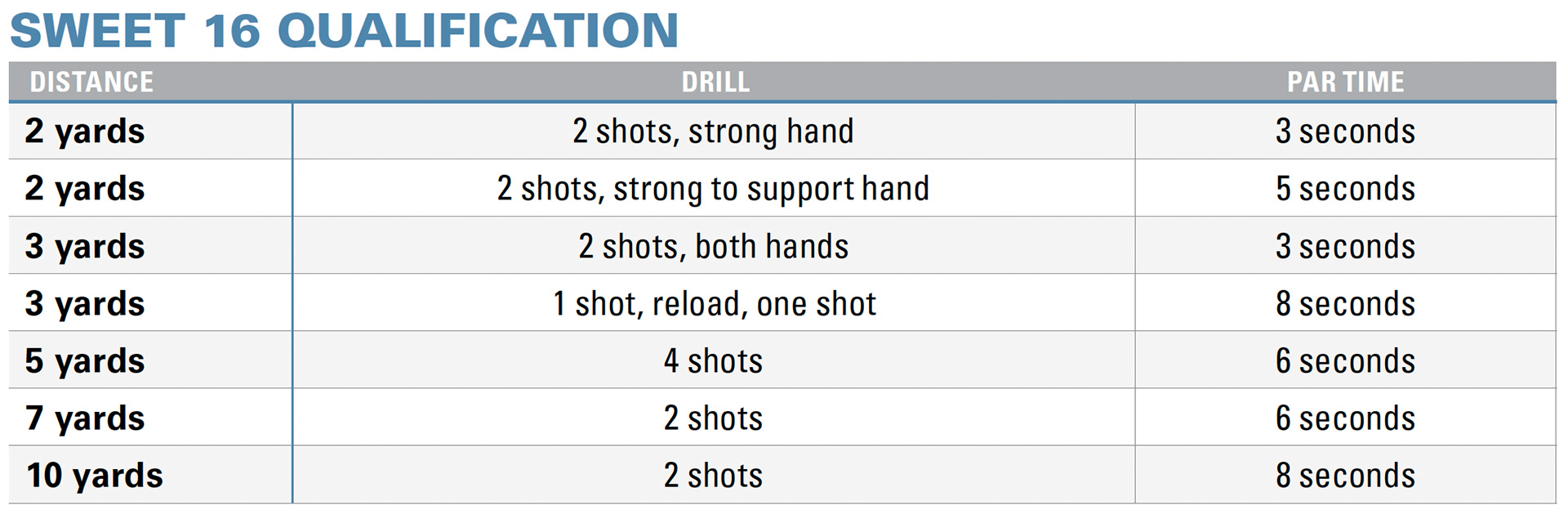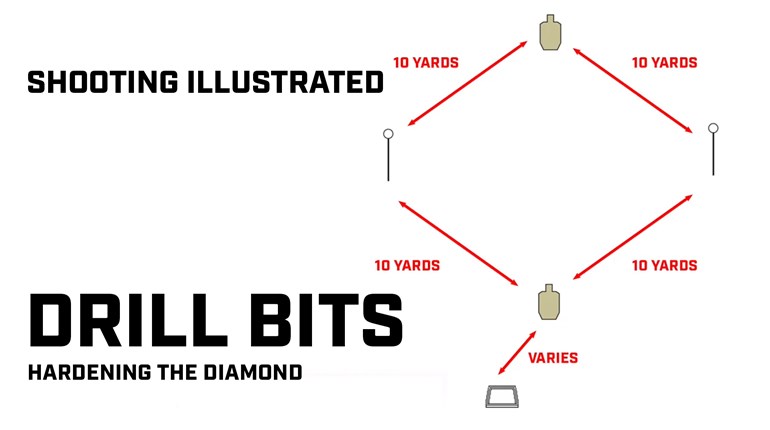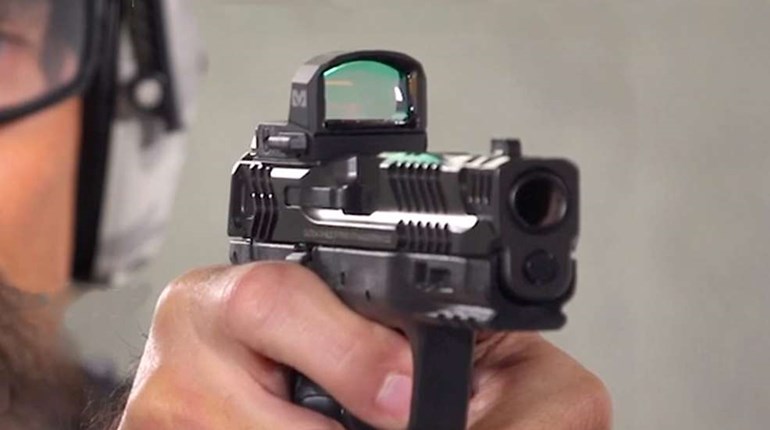
Shooting skill, like all other skills requires repetition. New gun owners need to learn the proper fundamentals and repeat them until they become second nature. A new shooter with a lesson in basic safety and marksmanship is at the same level as a driving student after their first experience on the road. As in driving, repetition develops unconscious competence and allows adjusting strategy while performing at a high level.

As a driver, you’re constantly situationally aware. If there’s an indication of danger, the experienced driver thinks only of the best tactic to avoid the danger without conscious thought of how to accomplish it using the controls of the vehicle. Real skill with a firearm requires the same level of competence.
ONE SHOT, TWO SIGHT PICTURES
Since we all know repetition is the mother of skill, this drill renders the maximum amount for skill building reps with a minimum expenditure of ammunition.
For accurate shooting within the constraints of time, the presentation of the gun must be safe, consistent and fast. The sight picture should be acquired during presentation and there when presentation is complete. At the time of full acquisition of the sight picture, the trigger finger should be on the pressure wall of the trigger, and if the sight picture is there, the trigger pressure should be increased until the gun fires. With practice, a reasonable speed for this to be accomplished is within about two seconds from concealment, and 1½ seconds from a belt holster. Once the trigger breaks, the shooter should re-acquire the pressure wall during recoil, resume the sight picture, and assess whether another shot is required.
The biggest impediment to accuracy with a pistol, either in shooting slowly or rapidly is trigger management. Everyone I train can see the sights and hold the gun well enough for reasonable accuracy. Poor accuracy is almost always due to poor trigger management due to anticipation or flinch. Flinch is an involuntary response and as such cannot be avoided if the affected shooter knows the exact instant the gun will fire. The answer to accuracy is the surprise break. If the sight picture is there, the shooter increases pressure until the gun fires. Anticipation can’t occur because the exact time of the shot can’t be predicted.
Many of my clients are new shooters and anticipation is a huge problem. When I explain the surprise break, I see skepticism because they can’t imagine shooting fast and not knowing the exact instant the gun will fire, but the surprise break can be compressed with repetition until multiple shots can be fired from the pressure wall with a fast, but smoothly increased pressure to the trigger. Accuracy has to come first and speed can then be acquired through repetition.
SWEET 16 QUALIFICATION
Using a full-sized silhouette, USPSA or half-scale silhouette at half distance, this drill develops an awareness of time versus accuracy, and covers almost all aspects of action or defensive shooting. If desired, two targets can be used to include transitioning to another target. The objective is to strive for accuracy, while developing awareness of needing more time to get accurate shot placement. I use the BLEA-1-R half-scale target with a two-by-three-inch 10-ring. If full-sized targets are used, double the distance.

This drill emphasizes the management of time and distance. To achieve a similar level of accuracy, longer shots require more time. While practice drills build skills through repetition, they also educate the shooter as to his or her skill level. People who don’t shoot structured practices normally greatly overestimate their skills and in a deadly force event, this could have disastrous consequences.
While the use of the support hand in a defensive encounter is relatively low, the use of one hand stages of the drill generally surprises shooters when they shoot almost as fast, and sometimes, more accurately with their support hand.
When I wrote my “Gun Digest Guide to Concealed Carry Handguns” book, I searched online for instances where defensive shooters had to accomplish a magazine change. I never found one. Still, gear manipulation is important and changing magazines builds skill in that area. An interesting addition would be to add a surprise dummy round in the magazine to reinforce the tap and rack mindset.
The five-yard stage where four shots are fired enforces proper grip and recoil management. If you have to adjust your grip after a few shots, you need work in that area.

The Sweet 16 Qualification requires speed in the close stages and accuracy in the longer stages. Hitting a two-by-three-inch 10-ring at two to five yards is pretty simple, but under the constraints of time, even highly skilled shooters drop points at seven and 10 yards, because they fail to slow down to match the accuracy requirements of the longer distances.
I’LL BE BACK
No, this drill doesn’t involve driving a car into a police station as in the “The Terminator” movie. It does reinforce getting to cover whenever possible. After watching several videos of citizens involved in defensive encounters, I’m amazed at how many people simply stand out in the open when cover is readily available.

The drill is to start at five yards with the gun holstered or placed on a table at 10 yards. There are two USPSA targets spaced six feet apart and cover at 10, seven and five yards. On the timer’s beep, the shooter runs back to cover behind the table and fires one shot at each target from right and left of the 10-yard cover. He or she then moves up to the seven-yard barrel for one shot left and right and repeats at the five-yard cover. Another party loads his magazine with one dummy round at a random point.
The idea is to reinforce the need to use cover if available. I allow shooters to shoot on the way to cover if they’re moving. But the second shot should be from behind cover. Having a dummy round pop up at some point in the high-intensity drill instills the conditioned reaction to tap and rack the gun as soon as they get a click, or nothing, as opposed to a shot.

While many shooters simply cycle the slide when nothing happens, this isn’t the best option. Concealed carry guns are carried close to the body and the magazine release is compressed to the body, sometimes getting pressure from ordinary movements. Most concealed carry guns will hold the magazine in place when it’s dropped slightly. If the magazine has dropped below engagement level, racking the slide gets nothing and consumes considerable time because the gun has to be re-grasped and another sight picture acquired. Tapping the magazine before racking costs much less time.

These three drills consume small amounts of ammunition while providing a high value in acquiring skills. They’re valuable to new shooters, as well as those who have extended shooting skills. They’re easy enough to not intimidate a new shooter, yet challenging to higher skilled shooters when trying to beat previous times.
The old adage is to shoot until you’re standing knee deep in a pile of spent brass. Unfortunately, this is currently both difficult to accomplish and expensive. There is no substitution for repetition, but every session should be concentrated on exceeding previous performance. That’s how real skills are acquired.



































